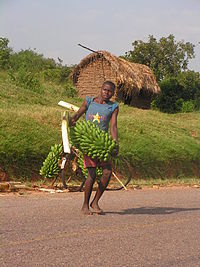- Matoke
-
Matoke, also known as Matooke or Ibitoke (in Rwanda), is a meal consisting of steamed green banana (or plantain) and is one of the national dishes of Uganda.
The medium-sized green fruits, which are of a specific group of banana, the East African Highland bananas (AAA-EAH),[1][2][3] are locally known as matoke. Bananas/plantains were a common staple crop around the Lake Victoria region of Uganda, and in the West and Kilimanjaro regions of Tanzania.[4]
Contents
Food preparation
Matoke are peeled, wrapped in the plant's leaves and set in a cooking pot (sufuria) on the stalks, which have been removed from the leaves. The pot is then placed on a charcoal fire and the matoke is steamed for a couple of hours in water placed in the bottom of the cooking pot. While uncooked, the matoke is white and fairly hard, cooking turns it soft and yellow. The matoke is then mashed while still wrapped in the leaves and often served on a fresh leaf. It is then eaten with a sauce made of vegetables, ground peanut, or some type of meat (goat and beef are common).
In Bukoba - Tanzania, matoke (or matooke) are cooked with meat or smoked catfish and beans or groundnuts. This method eliminates the need for preparing a separate sauce. In this recipe the matoke are not mashed. About 30 years ago this was the most common meal in Bukoba and would be eaten year round.
See also
- Banana
- Banana Cultivar Groups
- Cuisine of Rwanda
- Cuisine of Uganda
- Plantain
Photos
References
- ^ Karamura, D. and Mgenzi, B. 2004. On farm conservation of Musa diversity in the Great Lakes region of East Africa. African Crop Science Journal 12(1):75-83.
- ^ Karamura, D., Mgenzi, B., Karamura, E. and Sharrock, S. 2004. Exploiting indigenous knowledge for the management and maintenance of Musa biodiversity on farm. African Crop Science Journal 12(1).
- ^ Mgenzi, S.R.B., Mshaghuley, I.M., Staver, C. and Nkuba, J.M. 2005. A study on the analysis of Musa processing businesses and their support environment in Tanzania. A paper presented to the Musa processing businesses and their support environment workshop, Manila, Philippines 10-13 Oct. 2005. INIBAP [online], accessed 2011 June 14 from: http://platforms.inibap.org/processing/images/stories/file/pdf/tanzania.pdf.
- ^ Raschke, V., Oltersdorf, U., Elmadfa, I., Wahlqvist, M.L., Cheema, B.S.B. and Kouris-Blazos, A. 2007. Content of a novel online collection of traditional east African food habits (1930s – 1960s): data collected by the Max-Planck-Nutrition Research Unit, Bumbuli, Tanzania. Asia Pac. J. Clin. Nutr. 16(1):140-151 [online]. Accessed 2011 June 14 from: http://apjcn.nhri.org.tw/server/APJCN/Volume16/vol16.1/Finished/Raschke.pdf.
External links
Bananas and Plantains Cultivars Blue Java · Cavendish · Goldfinger · Grand Nain · Gros Michel · Lady Finger · Lacatan · Latundan · Pisang Awak · Plantain · Red · Rhino Horn · Saba · SeñoritaCultivar groups AA group · AAA group (Cavendish group) · AAA-EA subgroup (East African Highland bananas) · AAAA group · AAAB group · AAA group (Plantain group) · AABB group · AB group · ABB group · ABBB group · BB Group · BBB Group
Culinary usage Banana beer · Banana bread · Banana chips · Banana cue · Bananas Foster · Banana fritter · Banana ketchup · Banana powder · Banana pudding · Banana sauce · Banana split · Banana wine · Banania · Bánh chuối · Frozen banana · Ginanggang · Matoke · Maruya · Pisang goreng · Tonto · Turrón
Related topics  Category:BananasCategories:
Category:BananasCategories:- Burundian cuisine
- Rwandan cuisine
- Ugandan cuisine
- Uganda stubs
- Food stubs
Wikimedia Foundation. 2010.


